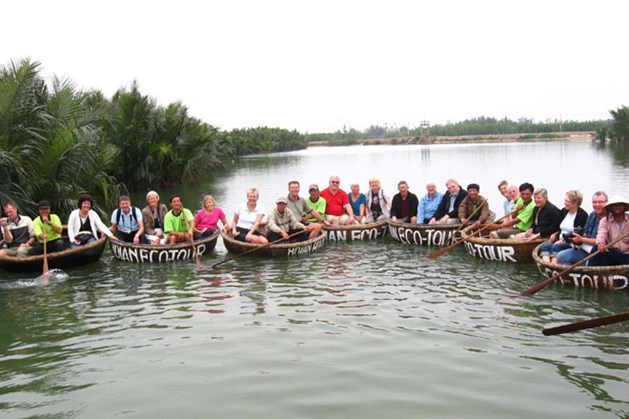A rising trend among visitors to Viet Nam is that of escaping the noisy urban areas and finding peace and tranquility in a rural space, enjoying the fresh air, dishes cooked by local people and altogether slower pace of life. Responding to the increasing demand, tourism operators have been offering guidance to local people to help them harness this opportunity.

From Hoi An...
Hoi An ancient town is one of the places where the concept of community tourism first emerged. More than 10 years ago, Hoi An began implementing unique tourism products attracting domestic and foreign tourists.
One of the most successful has been community-based tourism models focusing on traditional craft villages, such as Tra Que vegetable, Thanh Ha pottery and Kim Bong carpentry villages. Visitors show strong interest in these places, where they can experience the normal daily life of local people, cultivate soil to grow vegetables, knead clay pottery, saw wood, and learn about the cultural beauty, traditional customs and festivals of the villages.
In Cu Lao Cham island, this type of tourism emerged in 2009 with a homestay model on Bai Huong beach, and has since spread to other clusters of inhabitants across the island. Community-based tourism has continued to expand to Cam Thanh commune through ecotourism associated with water coconut ranges and the stream along Thu Bon river.
Tran Anh, chairman of the People’s Committee of Hoi An City said, “Recently, the city has introduced a policy to promote community tourism. Instead of focusing on developing luxury tourism as in the past, Hoi An has developed various types of homestay, which are now growing very well along the coastal areas.”
“In the past, farmers who invested their money in tourism tended to carefully consider every penny, therefore, community tourism was slow to reach the tourism industry. Today, local people acknowledge the potential of and profit from the tourism and trading sectors, and are encouraged and willing to develop tourism services and accommodation, joining hands to operate local tours. In Cam Thanh in particular, community tourism groups have been created to increase people’s income,” Tran Anh added.
Hoi An has strong potential for developing community tourism further, by diversifying community tourism spots according to local characteristics, such as An Bang beach in Cam An, An My agricultural village in Cam Chau, Van Lang river craft village, Thanh Dong organic vegetable village, Thanh Nhut, Thanh Nhi water coconut village in Cam Thanh, Bai Huong fishing village in Tan Hiep, Cua Dai fish village, Cam Nam corn village, An Phong bonsai village in Tan An, and Cam Ha flower village.
...To Ly Son Island
Ly Son Island in Quang Ngai Province is an ocean paradise. The island’s pristine beauty and delectable seafood specialties have brought a sudden increase in the number of tourists. In the summer particularly, more and more people are choosing Ly Son as a place to relax with friends and family, so much so that during peak times, some 8,000 to 10,000 travellers reach the island.
In order to keep up with this speed of island tourism development, a vast number of small and large businesses have invested in motels and hotels to serve tourists. There are currently more than 30 such places that can accommodate around 2,000 visitors at a time.
Besides experiencing spacious, modern and fully-equipped accommodation, many tourists prefer to stay at local homestays to save costs, while having the chance to experience the daily lifestyle of the friendly inhabitants on this beautiful island. From merely a few households at first, 20 homestays have now opened, mainly concentrated in An Vinh commune, and most of these have expanded in scale in response to the increasing number of guests.
However, work still needs to be done to bring the island up to the standard expected by visitors. After experiencing homestays in Ly Son, Nguyen Pham Ngoc Diem, a visitor from Quang Nam commented, “Compared to Tra Que vegetable village in Hoi An, the fom of community tourism here is still lacking professionalism and not yet offering significant differences.
In Hoi An, as well as having accommodation, visitors can also directly lend a hand growing and watering vegetables, plowing and working with farmers, and even harvesting vegetables to make their own dishes.”
According to Huynh Thi Phuong Hoa, deputy director of Quang Ngai Department of Culture, Sports and Tourism, homestays and community tourism are suited to Ly Son’s conditions, and can help develop and promote the region’s historical and cultural value and landscapes, while also creating an environment for local people to directly participate in tourism service provision, thereby having greater opportunities to earn more and gain profit from the development of the island’s tourism.
“This will also contribute to transforming the economic structure and employment of Ly Son Island.
The Department of Culture, Sports and Tourism has issued the “Guide to Homestay Business in Ly Son,” and is coordinating with the People’s Committee of Ly Son District to train homestay operators on the island, for example, on business registration, fire prevention and food safety,” says Hoa, “At the same time, we also organize classes for Ly Son’s homestay operators to study in Cu Lao Cham (Quang Nam) to gain greater knowledge and experience.”
TimeOut